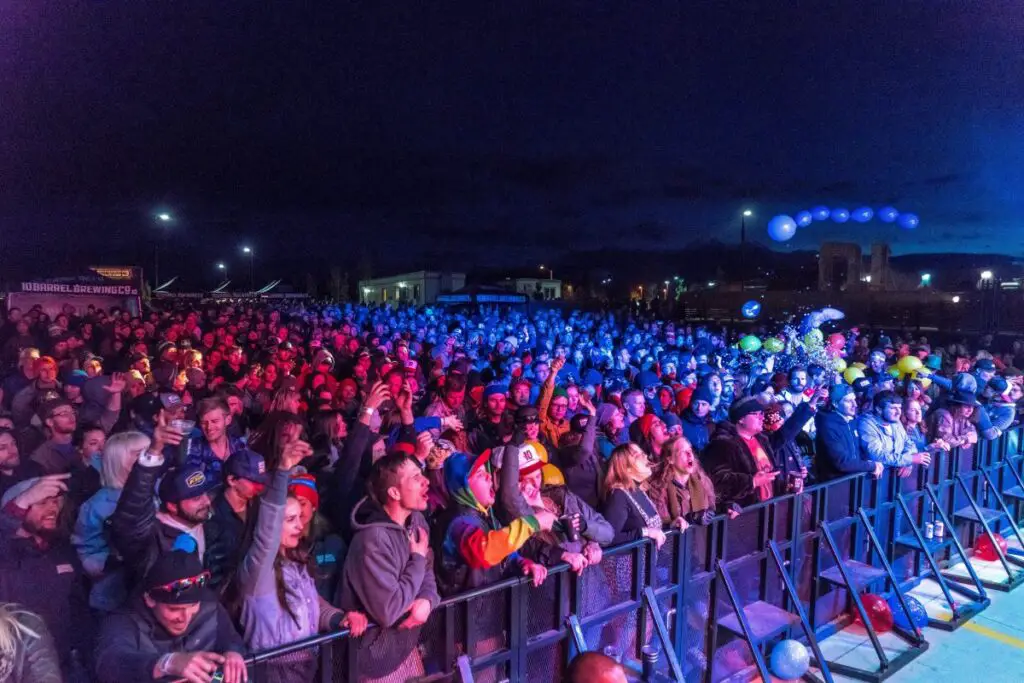Crowds Phobia and Autism: How to Tame Anxiety Overload
Crowds phobia or extreme fear of being in large crowds is a common social phobia that affects people of all ages and abilities. Women tend to be more affected by it than men, according to experts.
 For individuals with autism, being in the middle of loud crowds can cause sensory overload and crowds phobia, resulting in extreme anxiety or even meltdowns.
For individuals with autism, being in the middle of loud crowds can cause sensory overload and crowds phobia, resulting in extreme anxiety or even meltdowns.
Crowds phobia actually has a name: Enochlophobia. Fear of being in crowd can result from being overwhelmed due to intense noise, bright and/or flashing lighting (like strobes), and loss of personal space.
Some people find they can’t breathe in crowds where they are feeling jostled and may suffer panic attacks, while others may shut down until they are far away from situation.
Crowds phobia can occur anywhere or anytime, but it is most likely to occur at venues like large concerts, in shopping malls or outdoor markets during peak times like holidays, or when on vacation and touring a popular spot that everyone wants to see.
It’s especially common for people with autism to get overwhelmed in crowds. There are so many kinds of distractions that can just overload the senses. However, avoiding crowds altogether is usually not realistic or limiting.
Fortunately, there are ways you can overcome crowds phobia … or at least manage the situation and get through the experience when needed.
So keep reading, because I want to give you all the tips and advice that have worked for me, because I’m not a fan of crowds either, and hopefully they will work for you as well. By managing the challenges that crowds can present, individuals with crowds phobia can participate in desired community events and handle busy public spaces when necessary.
Here are some tips to make crowds and sensory stimulation more tolerable and less likely to cause extreme anxiety.
Managing Crowds Phobia: Prepare Ahead of Time
Advanced planning is key when facing crowded situations when you have crowds phobia but don’t want to miss out on an activity. Here are some ways to get ready:
- Pack sensory aids. Bring noise-canceling headphones, earplugs, or earmuffs to dull auditory input when needed. Sunglasses can also help filter visually overstimulating lights. Fidget toys give your hands a focusing activity and stimming outlet. Weighted blankets or lap pads can have a calming effect if you’ll be sitting (like at any outdoor concert). Having these items on hand means you can engage sensory modulation tools immediately when feeling overwhelmed.
- Identify retreat spaces. If possible, scope out the event location ahead of time. Look for quiet corners, lounges, or outdoor areas you can retreat to for a sensory break if needed. If that’s not feasible, have a plan to get to a bathroom, lobby, or other less crowded spot where you can regroup.
- Arrive early. Give yourself plenty of time to get acclimated before crowds peak. Rushed or last minute entries tend to heighten stress. Moving through spaces at off-peak times can also allow you to get the lay of the land.
- Let someone know your plans. Tell a family member or friend where you’re going and check in with them periodically. Having trusted allies who understand your needs can provide backup if you need support or to leave early.
- Prepare sensory anchors. Carry mints, scented oils, fidget toys, or other strong sensory inputs you can turn to help re-center yourself in overwhelming moments. Having these handy redirects your focus and calms the nervous system.
Coping Strategies for Managing Crowds Phobia Overload
When you’re in a crowded, hectic environment, having healthy coping strategies you can deploy if overwhelmed is vital:
- Wear headphones. Even without music playing, headphones send a signal to others that you may not want interaction. Have music or meditation tracks handy to play if you need to withdraw further into your own space.
- Ask for accommodations. Don’t be afraid to respectfully ask event staff for help avoiding triggers. For example, you may be able to access a reserved quiet seating area or have certain harsh lights turned down if they become agonizing. While it is not always possible, sometimes there are things that can be done, depending on the venue and circumstance.
- Take sensory breaks. Step outside, retreat to pre-planned calmer spots, or spend time in a bathroom stall to give your senses a rest from stimulation. Carry sensory anchors you can tap into during these breaks.
- Set time limits. If possible, attend crowded events for limited time periods only, building up stamina slowly over time. Or budget downtime after. Know your capacities and don’t overstretch them.
- Mask selectively. Wearing masks or face coverings, especially noisy environments, can limit overwhelming facial expressions and lip reading demands. Use sparingly if truly needed for regulation.
- Prioritize self-care. Listen to your body and leave if you need to. Crowds can deplete autistic individuals quickly. Rest and recharge after intense sensory experiences.
- Stim openly. Don’t worry about masking your stims or how they appear to others. Flap your hands, pace, rock, or fidget as much as needed. If you are comfortable doing so, explain to the people you are with (if they didn’t already know) that you have autism and that stimming helps you manage the overwhelming environment you are currently in. Stimming helps regulate emotions and process sensory information. Suppressing stims usually backfires by escalating stress.
Crowds Phobia and Making Self Care a Priority
Autistic or not, everyone has limits to how much stimulation they can manage before feeling mentally, emotionally and physically drained. Here are some self-care tips for recovering after intense sensory experiences like crowds:
- Get quiet rest. Seek low stimulation environments after crowed events. Turn off electronics, lights and unwind alone in a blanket nest or relaxing music. Give your nervous system time to reset.
- Tend to physical needs. Get good sleep after intense sensory days. Eat foods that make you feel grounded. Stim through walks, showers, or other activities that help process everything.
- Limit social interaction. You’ve expended social energy at the crowd, so conserve remaining spoons afterwards. Explain to loved ones that you need solo downtime.
- Practice mindfulness. Meditation, deep breathing exercises, and yoga can all help ground and center your mind after overstimulation. This reduces lingering stress.

- Stim intentionally. Get in focused stims sessions jumping, spinning, listening to familiar music or other activities that bring relief and joy after taxing sensory environments.
- Prioritize comfort. Wear your most comforting textures and lounge in relaxing spaces that feel safe. Surround yourself with items that bring you security.
- Revisit calming activities. Engage pastimes that stabilize your emotions like journaling, organizing belongings or absorbing special interests. Familiar hobbies boost resilience.
Listen to your needs above all else following intense sensory bombardment. You may require longer recovery than you expect. Rest is not a luxury—it’s an autistic necessity after heavy sensory loads like challenging crowds, especially when you have crowds phobia. Give yourself plenty of downtime.
Crowds Phobia: Picking Your Battles
While it’s important to develop strategies for handling stress and crowds, it’s also okay to acknowledge your limits and avoid intensely overwhelming situations when possible. Here are some tips for picking your battles wisely as an autistic person:
- Evaluate priority. How important is this event? Is attending worth possible sensory overload or can you comfortably skip it? Don’t override your needs for low priority situations.
- Check intensity. Gauge the crowd size, noise levels, and other stimulation factors. Consider visiting the space at off-peak times first. If it seems drastically over-stimulating, perhaps observe from afar or engage in other ways.
- Set participation boundaries. You can still show support through short visits, working booths or roles with escape options, attending remotely or helping behind the scenes without taking the full sensory brunt.
- Bring backup. Having an ally who can help strategically retreat when needed makes crowds safer. They can even fill in if you need to leave.
- Accept it’s okay to say no. You know your limits best. Politely declining is better than putting yourself in harm’s way. Good friends will understand.
- There will be more chances. Most events reoccur annually or similar types happen routinely. You’ll have other opportunities to participate when feeling more equipped.
- Seek balance. For every crowded event, make sure to schedule in ample downtime for yourself too. Caring for your needs is essential.
Learning when to say no or set participation boundaries around chaotic spaces prevents burnout. While facing some crowds can help expand tolerance in a controlled way, you don’t have to push yourself past healthy limits.
Listen to your gut when evaluating if a situation feels manageable or too intense. Prioritizing self-care is never the wrong choice.
Crowds Phobia: Practice Makes Progress When Navigating Crowds
Facing fears related to crowds can also help gradually increase coping capacities. But proceed with care when testing your exposure limits:
- Start small. Begin with lower stakes, smaller crowds or visiting massive spaces during off-peak times. This allows you to safely develop and test strategies.
- Try brief trials. Set brief time limits at first, like 5 or 10 minutes. Slowly increase your duration as tolerance builds across multiple experiences.
- Have an exit strategy. Scope out quiet spaces to retreat to or a trusted friend who can help you leave discreetly. Do not feel trapped.
- Reward yourself. Plan something enjoyable before and after as a celebration for stretching your boundaries. You earned it!
- Take breaks. Make sure to build in adequate down time between exposures to allow your nervous system to reset and rest. Don’t overdo it.
- Adjust as needed. If a strategy isn’t working, that’s okay! Regroup and try something new the next time. Be flexible.
- Respect your pace. This is not a rush process. Progress expands your capacities but happens gradually. Let things unfold at a rate that feels right.
- It’s okay to pause. If you hit an intolerable point, it’s okay to take a break and just maintain skills for a while before attempting expansion again. Listen to your limits.
With consistent practice outside our comfort zones, crowds can seem less daunting over time. But always respect when you’ve had enough stimulation for one day. Pushing too hard can backfire and increase anxiety. You set the terms for your own progress.
Autism and Crowds Phobia: Embracing Our Needs
 At the end of the day, we all deserve access to community and fulfillment. With the right preparation, coping methods and self-care, autistic individuals can often find ways to safely participate in many crowded spaces when we want to.
At the end of the day, we all deserve access to community and fulfillment. With the right preparation, coping methods and self-care, autistic individuals can often find ways to safely participate in many crowded spaces when we want to.
The key wording here, however, is “want.” Don’t give into pressure on attending something you know you cannot manage successfully.
If you do decide to go, always listen to your limits. If an event becomes intolerable, don’t hesitate to leave. Your comfort and well-being matter most.
There is no shame in choosing to accommodate your needs. Reframing challenges as opportunities to better support yourself can help you embrace your unique autistic traits. Extend your comfort zone where practical, but protect your mental health first. Don’t try and force a good time by using unhealthy coping mechanisms that can cause more chaos and harm than good.
Remember, you aren’t alone, and many people can’t handle large crowds and intense lights and noise, regardless of their age or abilities. Don’t let others pathologize your needs and crush autism inclusion. There are other activities out there you can enjoy, and focus on those instead. Your family and good friends will understand!
If you enjoyed this article, here are more blogs that you might find helpful.
Misconceptions About Autism that Leads to Stigmas and Stereotypes
Learn more about other stigmas and stereotypes that autistics face:
- Why Labeling People Can Lead to Stereotyping and Discrimination
- Autism Media Stereotypes: We’re Not All Geniuses, Savants, or Lonely
- Beyond Stereotypes: How Rain Man Revolutionized the Perception of Autism
- Absurd Plot About Autism and Evolution and Why It’s Harmful
- Moving Past the Tired Conspiracy Theory of Vaccines and Autism
- 3 Reasons Why Pathologizing Crushes Autism Acceptance and Inclusion
- The Hidden Hurdles: Challenging Autism Stigmas in Today’s Politics
- History of Autism: Revealing Shocking Mysteries from the Past
- Knocking Down the Stigma to Autism Obsession